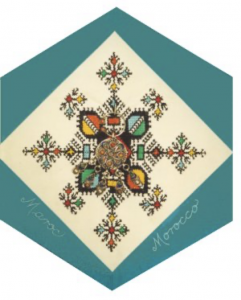Morocco

The Block
Hand-made embroidery plays an important part in Moroccan culture and each city has developed its own unique and varied style. This block, made with materials contributed by brothers Jalil & Khalid Ben Thami, features a typical design from the Meknès area, renowned for its distinctive needlework. The abstract and repetitive patterns reflect Moroccans’ preference for non-literal subject matter, while the freedom with which the motif is arranged displays a sense of originality. The bright colours pick up the enamelled hues in the fibule, in the centre, a specially crafted brooch worn by Moroccan women to keep their hand-woven shawls closed.
Cultural Profile
The Arabs call Morocco Al Maghreb al-Aksa (meaning ‘the land of the furthest west’), because of its location on the extreme northwestern corner of Africa. Its geography is varied, with the snow-caped Atlas Mountains, fertile valleys and hot Saharan desert. It abounds with traditional walled towns, enclosing markets, mosques and houses built around hidden courtyards. The official languages are Arabic and Berber. French is also taught at school, a legacy from the French colonial rule over the country. Spanish is also spoken. The indigenous people who have lived in Morocco for thousands of years, such as the Shilha and the Riffian, belong to the large Berber ethnic group. Arabs also make up a sizable part of the population. The groups have intermingled over the past centuries.
Moroccans have a deep sense of courtesy and respect for others, and family is the centre of their social life. They spend their free time visiting and going to souks (markets composed of narrow walkways and tunnels), to buy and sell goods and to socialize. Hospitality is important to Moroccans, and tea always welcomes visitors to any home.
Morocco’s cultural traditions, deeply rooted in Islamic and Berber customs, have been influenced over the years by other cultures, including Jewish, African and Mediterranean. Traditional Berber music is connected to storytelling and is an important aspect of moussems (religious festivals), weddings and other activities that celebrate the arts and popular customs.
Moroccans are known for many crafts including fine embroideries. Embroidery was taught to young girls so that they could prepare their trousseau while growing up. They added their own new pieces to older ones that had been passed down from previous generations. Today, clothing and household items almost always feature intricate embroidery such as the one shown on the block, thought they are not exclusively hand-made anymore.
Woven carpets, created in intricate designs that have been passed down through generations, are also prized possession. Berber rugs in particular, with their abstract non-geometric designs, display a unique rug weaving style. Weavers are encouraged to follow their own inspiration for designs, resulting in fascinating and changing shapes and colours. Moroccans are also known for refined silver, brass and copper-ware. Colourful or earth toned pottery is also made. The iconic shape of the tajine dish comes to mind when thinking of Moroccan pottery, but also that of the zelij, the colourful ceramic mosaics whose complex geometry can be mind-boggling. Leather-work (called maroquinerie in French) has a long history in Morocco. It spread to Europe through the Moroccan presence in Spain during Medieval times. It is still made today in the city of Fez using centuries-old techniques.
Moroccans have been coming to Canada since 1946, settling in Ontario, Quebec, the Maritimes, Manitoba and Saskatchewan. As of 2011, there were over 71,000 people of Moroccan ancestry living in Canada. One of their cultural influences, their cuisine, is featured in restaurants across Canada
Sponsor: The Urquhart family, in memoriam Kenny John & Mina Urquhart
